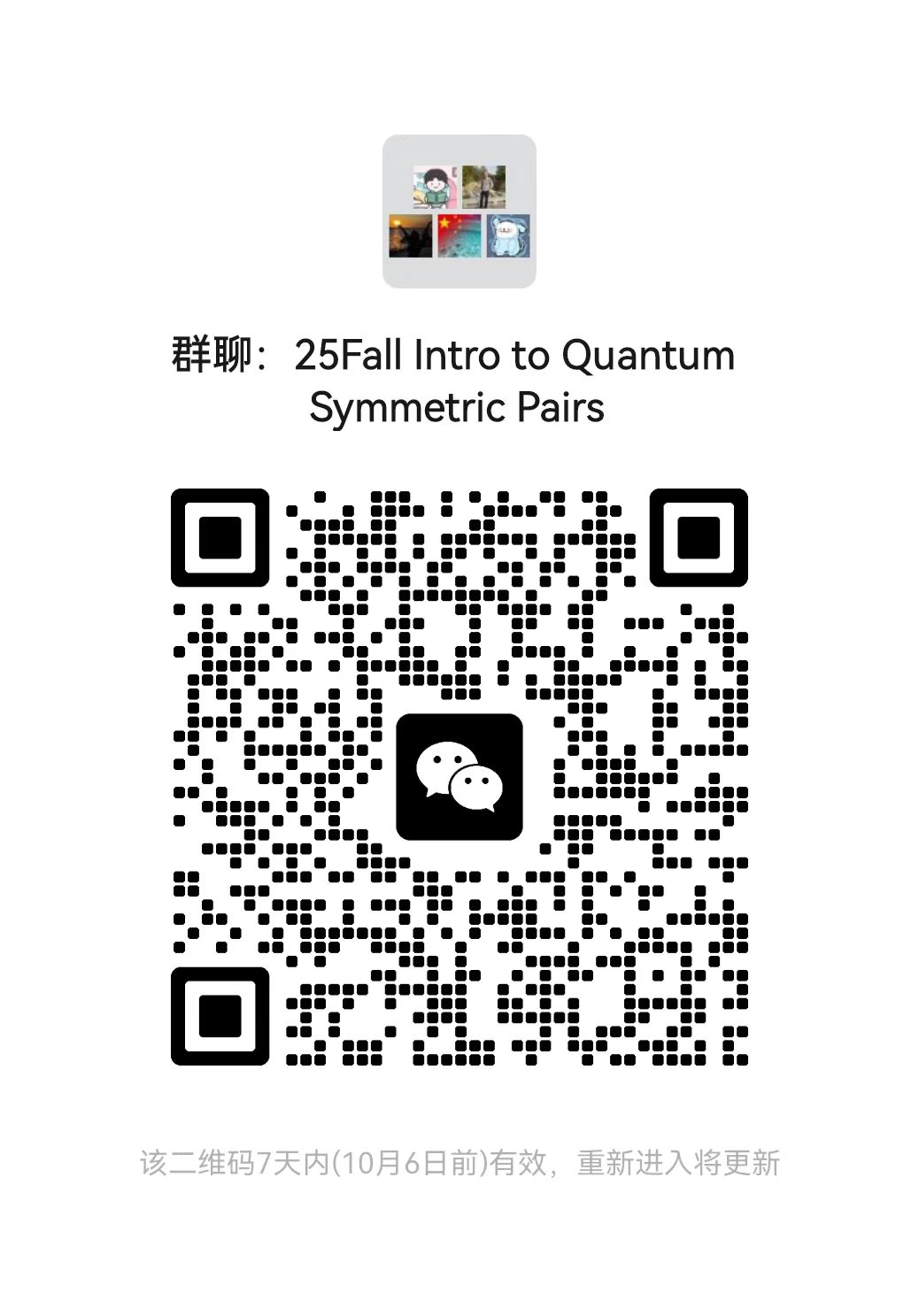Introduction to quantum symmetric pairs
This is a short (18 class hours) course which aims to get researchers acquainted with quantum symmetric pairs, a contemporary topic which has developed in a rapid pace during the last decade.
A Lie algebra $\mathfrak{g}$ together with the fixed-point subalgebra $\mathfrak{g}^\theta$ of an involutive automorphism $\theta$ is called a symmetric pair. For example, let $\mathfrak{g}$ be a matrix Lie algebra and let $\theta$ be "minus the transpose". For a suitable Lie algebra $\mathfrak{g}$ (for example, finite-dimensional simple), its universal enveloping algebra has a deformation $U_q(\mathfrak{g})$ in the class of Hopf algebras (Drinfeld-Jimbo quantum group, quantized enveloping algebra). It has become clear since the 1990s that, if you arrange the involution $\theta$ carefully, then you can define a quantum symmetric pair $(U_q(\mathfrak{g}),U_q'(\mathfrak{g}^\theta))$. The second member is a coideal subalgebra of $U_q(\mathfrak{g})$ also known as $\imath$-quantum group.
We will discuss the basic constructions and their motivations. We will explore some of the representation theory, some applications in mathematical physics and some variations of the construction.
A Lie algebra $\mathfrak{g}$ together with the fixed-point subalgebra $\mathfrak{g}^\theta$ of an involutive automorphism $\theta$ is called a symmetric pair. For example, let $\mathfrak{g}$ be a matrix Lie algebra and let $\theta$ be "minus the transpose". For a suitable Lie algebra $\mathfrak{g}$ (for example, finite-dimensional simple), its universal enveloping algebra has a deformation $U_q(\mathfrak{g})$ in the class of Hopf algebras (Drinfeld-Jimbo quantum group, quantized enveloping algebra). It has become clear since the 1990s that, if you arrange the involution $\theta$ carefully, then you can define a quantum symmetric pair $(U_q(\mathfrak{g}),U_q'(\mathfrak{g}^\theta))$. The second member is a coideal subalgebra of $U_q(\mathfrak{g})$ also known as $\imath$-quantum group.
We will discuss the basic constructions and their motivations. We will explore some of the representation theory, some applications in mathematical physics and some variations of the construction.

Lecturer
Date
17th October ~ 21st November, 2025
Location
| Weekday | Time | Venue | Online | ID | Password |
|---|---|---|---|---|---|
| Friday | 14:20 - 16:55 | A3-1a-205 | ZOOM 04 | 482 240 1589 | BIMSA |
Prerequisite
Basic courses in algebra, representation theory and Lie theory. Some knowledge of Hopf algebras and quantum groups (quantized universal enveloping algebras) will be useful, but will be reviewed.
Syllabus
We will explore a selection of the following topics, depending on time and interest:
1. Symmetric pairs and symmetric spaces in the finite-dimensional case. Real forms. Satake description.
2. Quantum symmetric pairs in the style of Letzter and other approaches (Gavrilik-Klimyk, Noumi et. al.)
3. Cylinder braiding and canonical bases (K-matrix)
4. Finite-dimensional representation theory: highlights and applications
5. Variations and generalizations (pseudo, super, Kac-Moody)
6. Quantum symmetric pairs of affine type and trigonometric K-matrices.
1. Symmetric pairs and symmetric spaces in the finite-dimensional case. Real forms. Satake description.
2. Quantum symmetric pairs in the style of Letzter and other approaches (Gavrilik-Klimyk, Noumi et. al.)
3. Cylinder braiding and canonical bases (K-matrix)
4. Finite-dimensional representation theory: highlights and applications
5. Variations and generalizations (pseudo, super, Kac-Moody)
6. Quantum symmetric pairs of affine type and trigonometric K-matrices.
Reference
There is not yet a standard textbook on this contemporary topic. Some survey material can be found in:
Weiqiang Wang, "Quantum symmetric pairs", Proc. Int. Cong. Math., vol. 4 (2022).
Stefan Kolb, "Quantum symmetric Kac-Moody pairs", Adv. Math. 267 (2014).
Andrea Appel and Bart Vlaar, "Boundary transfer matrices arising from quantum symmetric pairs", Indag. Math. (2025).
Weiqiang Wang, "Quantum symmetric pairs", Proc. Int. Cong. Math., vol. 4 (2022).
Stefan Kolb, "Quantum symmetric Kac-Moody pairs", Adv. Math. 267 (2014).
Andrea Appel and Bart Vlaar, "Boundary transfer matrices arising from quantum symmetric pairs", Indag. Math. (2025).
Audience
Advanced Undergraduate
, Graduate
, Postdoc
, Researcher
Video Public
Yes
Notes Public
Yes
Language
English
Lecturer Intro
Dr. Bart Vlaar has joined BIMSA in September 2022 as an Associate Professor. His research interests are in algebra and representation theory and applications in mathematical physics. He obtained a PhD in Mathematics from the University of Glasgow. Previously, he has held positions in Amsterdam, Nottingham, York and Heriot-Watt University. Before coming to BIMSA he visited the Max Planck Institute of Mathematics in Bonn.




